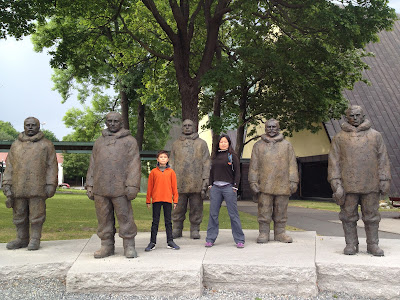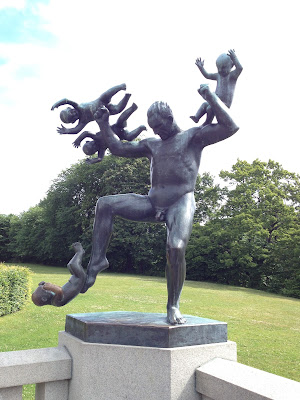Oslo
We flew into Oslo and enjoyed the Viking Museum. The wonderfully-preserved thousand-year-old boats are beautiful.
Nearby is the Polar Exploration Museum which pays tribute to brave, hardy, and determined men like Roald Amundsen and Fridtjof Nansen.
Our next stop was the Vigelund Sculpture Park, which has an impressive set of works which movingly and beautifully express every phase of human life, various relationships and emotions with great tenderness and no little humor. I loved it.
From there we flew to Bergen and embarked on a four hour ferry and road trip to our home exchange in the village of Leikanger on the Sognefjord.
It was the first week of July, and ski season had just ended according to a woman we met. We drove past melting ice fields and roaring waterfalls. The landscape enchanted at every turn.
We stopped for the night at Vangsnes, having missed the last ferry and because the boys wanted to watch the World Cup soccer match. Meanwhile Z and I wandered down to the water and caught the most spectacular sunset imaginable at 11pm!
The next day we took our first of many ferry rides.
The house was heavenly, perched on a fairly steep hill with large windows in the kitchen/dining/living area offering breathtaking views of sky, sea, and mountains. I never got tired of looking out of them.
The moon at midnight
We were so inspired by the scenery that we wrote some haikus and painted with watercolors.
by Nerissa
by Zoe
Trevor's poem was about Vikings...
Nigardsbreen at Jostedal Glacier
Our first big adventure was a blue ice walk on the Nigardsbreen arm of the Jostedal Glacier. It was a warm and sunny day. We took a short boat ride with our guide across the lake and walked to the retreating glacier.
View from the car park. Not too shabby
View towards the car park from the glacier.
Then we put on our crampons, harnesses, helmets, and ice picks.
Wouldn't want to fall to our deaths into a crevasse now would we?
We were roped together so if one person fell, the others would fall, too. Ha ha.
It was like walking on a dirty snow cone.
Ice which is very compacted and has few air bubbles absorbs red light and thus appears blue.
Some areas were steep but nothing particularly difficult.
Towards the end we found a blue ice cave to enter.
The ice inside was very slippery and solid, not the crunchy granules of the outer glacier.
Dream fulfilled. What's next, climbing ice falls?
Kayaking near Leikanger
Our generous hosts allowed us to use their community kayaks. We biked down the hill and launched from the pebbly beach next to the elementary school. The water was crystal clear but brisk.
H E A V E N
Families were picnicking next to the volleyball court and soccer pitch, all free for the community. What a life!
We even spotted a shy porpoise. Just a dark fin that disappeared quickly.
The Geirangerfjord
Our second adventure was an overnight trip to the Geirangerfjord,
perhaps the most famous of them all because of it's narrow width and beautiful waterfalls.
After another spectacular drive, filled with bucolic farmhouses and dramatic vistas, we made it to Hellesylt where we boarded the ferry to Geiranger.
We stayed in a quaint cabin at the Geiranger Ferry Center, definitely recommended.
Skageflå
For a small fee the ferry center took us in a small boat to Skageflå, an abandoned farm clinging to the mountainside 820 feet up! It has a jaw-dropping view of the seven sisters waterfall which in times of drought was the farm's only water source. That meant a steep hike down, a brisk row across, and an uphill climb just to fetch water. Talk about hardy pioneers!
The trail up to the farm is narrow and steep-- difficult when it snows. Talk about isolated.
The family who lived here tied a rope to their children's waists and the other end to a big rock to make sure they didn't go falling off the cliff.
Sod roof farmhouse. Probably freezing in the winter.
It is said that once the family did not want to pay taxes, so when the tax collector came up the path, they removed the wooden ladder and he had to turn around and leave them alone.
See how steep it is?!
Storseterfossen
Near Geiranger is the Storseter Waterfall which is reached by way of a short hike.
You can actually walk behind the falls into the cave created by the erosion of the flow.
Visiting with friendly sheep along the way.
Flydalsjuvet
On our way out of Geiranger we stopped at the Flydalsjuvet Vista Point which unfortunately has been made safer so you can't get that dramatic standing-on-a-precipice photo anymore. But it is beautiful.
I love how nature can make you feel so small.
Dalsnibba
Dalsnibba is another famous viewpoint farther on the road,
looking over the Geirangerfjord in the distance.
Don't know the name of this river, but it was gushing and the most beautiful blue due to the silt it carries from the mountain. Glorious!
And walking through the pines over the mossy rocks was also so enchanting.
Urnes Stave Church
We took a ferry from the quaint village of Solvorn across the Lusterfjord to Urnes where there is a famous wooden stave church from the 12th century. I just adore the brightly colored wooden houses which felt so very midwestern American! Obviously we copied them, not the other way around.
The small church has beautiful carvings in a Viking/Celtic influenced style.
Tvinefossen
We just stumbled upon this waterfall, which has got to be one of the most gorgeous natural falls I've ever seen. You can just walk right up to it.
View over the Sognefjord
Bergen
The Bryggen, or waterfront.
The history of the cod fishing industry in the North Sea is fascinating.
We took a great tour and learned about the austere monastic life of the (German) Hanseatic League officers.
This was the room/bed of the head honcho, which is basically just a closet to keep the warmth in winter because they had no heating!!! The men and boys posted there were not allowed to marry or dally with local women, who were forbidden from certain parts of the wharf.
All the world loves dried cod! In Spain we call it bacalao.
It was the end of our two weeks in Norway, and I was so thoroughly charmed that I was ready to buy a Norweigan flag and apply for citizenship, until I saw the whale meat at the fish market.
Leproseet Museum
Leprosy is also known as Hansen's disease, after a Norwegian doctor who made great strides in the understanding of the disease. The museum where they used to quarantine patients suffering from this then-incurable disease was sobering to say the least.
Leprosy is a slow-growing bacterial infection which causes parts of the body to die and fall off.
To cheer ourselves up after that, we went for a walk.
The enchanted woods.
The view from the top of the hill.
T and I will never forget the raspberries. Growing wild everywhere, we picked and picked til our fingers were stained with red. Small but sweet and juicy, we braved thorns and bugs for the succulent treats.
Of all the incredible places we've visited in Europe, this one stays with me the most. Yes, restaurants are ridiculously expensive. But aside from that, the people speak English perfectly and really you just have to go. In summer.


























































































No comments:
Post a Comment